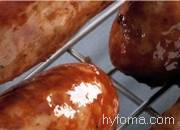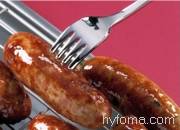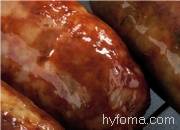
| Herstellungsverfahren > Fleisch & Fisch > Fleischverarbeitung |
Dieser Artikel ist noch nicht auf Deutsch vorhanden
Meat and poultry processing
Beef, pork and poultry are the main types of meat processed in Europe.The activities of the meat sector can be divided into three areas, slaughtering, meat cutting and further processing.
Cutting is a size reduction of large to medium sized parts of food material. For cutting, knifes, blades, cleavers and saws are used. Meat is cut post slaughter to dress and split carcases, to remove offal and to remove appendages such as head and fat and, where required, excess fat and bones. Carcases are further reduced into retail cuts of joints by the removal of bone, skin and fat. After cutting the meat, the fresh meat may be stored and dispensed under refrigeration. It can be sold in portions, or it may be combined with other food.
The further processing of meat into ham, bacon, sausage, etc. is primarily done for preservation purposes but it is also important to produce tasty food. In the processed-meat industry, raw meats, either whole muscles or altered meat particles, are restructured to the predetermined product characteristics.
For coarse-ground products, the meat particles are substantially reduced and then restructured back into a different physical form. The finished products, such as dry sausage and smoked sausage, still present recognisable meat parts.
The goal of muscle product processing is to keep an original intact tissue appearance in the finished product. The products, such as ham, roast beef, and turkey breast, are produced from whole muscles or sectioned muscles.
The emulsifying process forms a matrix in which the fat particle is encapsulated with the protein membrane.
Grinding reduces the meat particle size, and the mixing assures uniformity of chemical
composition as well as protein extraction. The chopping process also reduces particle size and obtains salt-soluble protein. The major processing equipment includes injectors and massagers for muscle products, grinders and mixers for coarse-ground products, and choppers and emulsifiers for emulsified products. Injecting and massaging processes facilitate brine distribution and protein extraction.
Preservation involving heat (cooking or frying) and dehydration produces foods that can be kept for an extended time at appropriate storage conditions (temperature and packaging). Preservation techniques, such as fermentation, smoking, and salting of meat, sausage, etc. are also used for diversification of the market selection. All these processes offer limited extension of the shelf-life by altering the environmental conditions conducive to microbial growth.
Process Product example Preservation principle
- Fermentation some sausages, dairy products, herring, and other fish lowering of pH below tolerance limits of many micro-organisms
- Smoking meat products, cheese, and fish some bacteriostatic effect of smoke; drying of the surface layers; sometimes heat effects
- Salting (brining and curing)
Sugaring candied fruits, jams, and jellies lowering of aw as in salting
Pickling vegetables, fish, and mushrooms pH control or increased salt content inhibits microbial growth
The water activity (aw) of a given food is defined as aw = pf/pw, where pf and pw are the pressures of water vapour in equilibrium with the given food system and with pure water, respectively, both at the same temperature.
The emulsifying process is required for products such as ham, shoulder, bresaola, and turkey.
Traditional injection in “vein” was abandoned, and today the technique uses in multi-needle injectors, which allow a higher productivity and a major spread of pickle. The injector injects a predetermined dose of pickle containing different additives and ingredients (salts, polyphosphates, ascorbate, caseinate, nitrate, nitrite, glutamate, etc) inside the ham or shoulder mass. After the injections, a process takes place, which allows complete homogenisation of the ingredients and of the additives into the product, and it also allows the extraction of a proteinous/saline exudate with binding effect. This process involves in massaging the meat inside a container turning around an axis (vertical or inclined) in a continuous or intermittent way, under vacuum and/or at a refrigerated temperature. Salting by dry salt is required for the production of cured (uncooked) ham, bacon, and coppa. For the latest two products it can be also made in the churn).
Raw meats, after these preparation processes, are stuffed into casings to form a defined geometric shape and size. During these processes, rheological properties are critical to the equipment performance and final product quality.
The equipment used for cutting in meat processing includes power operated cleavers and
circular or straight saws for splitting carcases, and band saws for further reduction of the carcases. These are all electrically operated. Special derinding machines are used for separating rind and fat from pork carcases.
The meat sector is very diverse in terms of its products due to specific local tastes and traditions. However, there are some processes that are commonly used. Three of them are decribed below in more details:
- canned meat (beef muscle in gelatine),
- cooked ham (muscle and coarse-ground and emulsified), and
- cured ham production.
 back to top
back to top

 Firmen
Firmen




